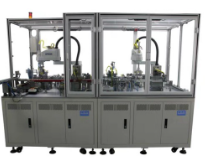Approaches to automated equipment fault detection
06/05/2021 21:19:17 人气:
Common methods for fault detection in automated equipment:
1. Check all power and air sources to the automation equipment. Power supply, air source problems will often lead to automation equipment failure. For example, there are problems with the power supply, including the failure of the entire workshop power supply, such as power supply power is low, insurance burned out, poor contact with the power plug, etc.; air compressor is not turned on, pneumatic triplex or duplex is not turned on, the current limiter is turned off and so on. Detection of automation equipment should include the following aspects: power supply, including the power supply of each piece of equipment and the workshop power supply and pneumatic devices required for the air pressure source.
2. Check the sensor position of the automation equipment for offset. Due to the negligence of equipment maintenance personnel, there may be errors in the position of certain sensors, such as not in place, sensor failure, sensitivity failure, etc.. It is necessary to frequently check the sensing position and sensitivity of the sensor, and adjust the deviation in time, and replace the sensor immediately if it is broken. Very often, in addition, due to the vibration of automation equipment, most of the sensors in the long term after the use of the position will be loose, so in the daily maintenance should always check the sensor position is correct, whether it is fixed firmly.
3. Check the relays of the automation equipment. The current limiter and pressure reducing valve relays, like the magnetic inductive sensors, will also have a sticky lap over a long period of time, thus failing to ensure that the electrical circuits are functioning properly and need to be replaced. In gas circuit systems, the pressure regulating springs of restrictors and pressure reducing valves can also loosen or slip with the vibration of the equipment. These devices, like sensors, are components in automation equipment that require routine maintenance.
4. Check the electrical, solenoid, and air circuit connections within the components If none of the above three steps reveal any problems, then check all circuits. Look for breaks in the wires in the circuits, especially the wires in the wireway if they have been cut by the wireway due to pulling. Check the air tubes for damaging creases or cracks. If the air tube is badly creased or cracked, replace it immediately.
5. Check the solenoid valve with or without commutation action, the solenoid valve is relying on the solenoid suction spool to make the cylinder for commutation, when the solenoid failure, the spool does not act, resulting in the cylinder can not act. If there is much water and dust in the gas circuit, it will also lead to the valve spool stuck and blocked, which will lead to the cylinder can not be acted.
6. After ensuring that the above steps are correct, the fault may appear in the controller of the automation equipment, but it can never be a program problem. First of all, do not be sure that the controller is destroyed, as long as there has not been a serious short-circuit, the controller has an internal short-circuit protection, a general short-circuit will not burn the controller.



